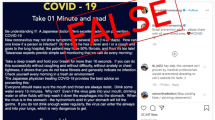Abstract
Nowadays, information is crucial in the configuration of the socio-political space. Data relevance in both decision making and decision taking has exponentially increased. Content examination, social network analysis, information propagation (including epidemic and statistical modeling analysis), or sentiment analysis techniques are currently used to classify and curate information. Nonetheless, mis- and dis-information are among the major current cybersecurity challenges, as it is hindering the very health of our democratic systems. As a result, there is an urge to devise and implement technical solutions to detect and deter the propagation of unreliable information.
In this work, we consider a specific case in the taxonomy of the complex scenarios of mis- and dis-information phenomena, the so-called fake news. In short, we used labeled data set containing fake news, which are going to be detected by means of traditional natural language processing techniques and advanced deep learning approaches. Our intention relies on comparing the accuracy of simple methods (namely, traditional natural language processing) with respect to modern and complex techniques in the deep learning family. The study of the above mentioned dataset hints that adopting complex techniques may not always guarantee achieving better classification performances.
Access this chapter
Tax calculation will be finalised at checkout
Purchases are for personal use only
Similar content being viewed by others
Notes
- 1.
https://trends.google.com/trends/explore?date=today%205-y&q=fake%20news [Last accessed 19 April 2020].
- 2.
GitHub, https://github.com/dongkwan-kim/HBTP [Last accessed 26 Jan 2020].
- 3.
Term frequency – Inverse document frequency (TF-IDF).
- 4.
https://spacy.io/ [Last accessed 26 Jan 2020].
- 5.
en_core_web_lg, pre-trained English statistical models. English multi-task CNN trained on OntoNotes, with GloVe vectors trained on Common Crawl.
- 6.
https://radimrehurek.com/gensim/ [Last accessed 26 Jan 2020].
- 7.
https://scikit-learn.org/ [Last accessed 26 Jan 2020].
- 8.
https://scikit-learn.org/stable/ [Last accessed 26 Jan 2020].
- 9.
NLP techniques to map real numbers into vectors for words in a corpus.
- 10.
https://radimrehurek.com/gensim/models/doc2vec.html [Last accessed 26 Jan 2020].
- 11.
https://keras.io/layers/recurrent/#lstm [Last accessed 26 Jan 2020].
- 12.
https://keras.io/layers/recurrent/#gru [Last accessed 26 Jan 2020].
- 13.
TP/FP represents True/False positive and TN/FN stands for True/False negative.
References
Bovet, A., Makse, H.A.: Influence of fake news in Twitter during the 2016 us presidential election. Nat. Commun. 10(1), 7 (2019)
Cho, K., Van Merriënboer, B., Gulcehre, C., Bahdanau, D., Bougares, F., Schwenk, H., Bengio, Y.: Learning phrase representations using rnn encoder-decoder for statistical machine translation. arXiv preprint arXiv:1406.1078 (2014)
Gers, F.A., Schmidhuber, J., Cummins, F.: Learning to forget: Continual prediction with LSTM (1999)
Greff, K., Srivastava, R.K., Koutník, J., Steunebrink, B.R., Schmidhuber, J.: LSTM: a search space odyssey. IEEE Trans. Neural Networks Learn. Syst. 28(10), 2222–2232 (2016)
Grinberg, N., Joseph, K., Friedland, L., Swire-Thompson, B., Lazer, D.: Fake news on Twitter during the 2016 us presidential election. Science 363(6425), 348 (2019)
Hochreiter, S., Schmidhuber, J.: Long short-term memory. Neural Comput. 9(8), 1735–1780 (1997)
House of Commons. Digital, Culture, Media and Sport Committee: Disinformation and ‘fake news’: Final report. Technical report, February 2019. http://shorturl.at/ikwI7. Accessed 26 Jan 2020
Kim, J., Kim, D., Oh, A.: Homogeneity-based transmissive process to model true and false news in social networks. In: Proceedings of the Twelfth ACM International Conference on Web Search and Data Mining, pp. 348–356. ACM (2019)
Le, Q., Mikolov, T.: Distributed representations of sentences and documents. In: International Conference on Machine Learning, pp. 1188–1196 (2014)
Liu, X., Nourbakhsh, A., Li, Q., Fang, R., Shah, S.: Real-time rumor debunking on Twitter. In: Proceedings of the 24th ACM International on Conference on Information and Knowledge Management, pp. 1867–1870 (2015)
Ma, J., Gao, W., Mitra, P., Kwon, S., Jansen, B.J., Wong, K.F., Meeyoung, C.: Detecting rumors from microblogs with recurrent neural networks. In: The 25th International Joint Conference on Artificial Intelligence, pp. 3818–3824. AAAI (2016)
Ma, J., Gao, W., Wong, K.F.: Detect rumors in microblog posts using propagation structure via kernel learning. In: The 55th Annual Meeting of the Association for Computational Linguistics. Association for Computational Linguistics (2017)
Rapoza, K.: Can ‘fake news’ impact the stock market? In: Forbes (2017). http://tinyurl.com/t63aler. Accessed 26 Jan 2020
Rumelhart, D.E., Hinton, G.E., Williams, R.J., et al.: Learning representations by back-propagating errors. Cogn. Model. 5(3), 1 (1988)
Zannettou, S., Sirivianos, M., Blackburn, J., Kourtellis, N.: The web of false information: rumors, fake news, hoaxes, clickbait, and various other shenanigans. J. Data Inf. Qual. (JDIQ) 11(3), 10 (2019)
Zhou, X., Jain, A., Phoha, V.V., Zafarani, R.: Fake news early detection: a theory-driven model. arXiv preprint arXiv:1904.11679 (2019)
Zhou, X., Zafarani, R.: Fake news: a survey of research, detection methods, and opportunities. arXiv preprint arXiv:1812.00315 (2018)
Zhou, X., Zafarani, R., Shu, K., Liu, H.: Fake news: Fundamental theories, detection strategies and challenges. In: Proceedings of the Twelfth ACM International Conference on Web Search and Data Mining, pp. 836–837. ACM (2019)
Acknowledgements
This project has received funding from the European Union’s Horizon 2020 research and innovation programme, under grant agreement No. 872855 (TRESCA project), and from Ministerio de Economía, Industria y Competitividad (MINECO), Agencia Estatal de Investigación (AEI), and Fondo Europeo de Desarrollo Regional (FEDER, EU) under project COPCIS, reference TIN2017-84844-C2-1-R, and the Comunidad de Madrid (Spain) under the project CYNAMON (P2018/TCS-4566), cofinanced with FSE and FEDER EU funds.
Author information
Authors and Affiliations
Corresponding authors
Editor information
Editors and Affiliations
Rights and permissions
Copyright information
© 2021 The Editor(s) (if applicable) and The Author(s), under exclusive license to Springer Nature Switzerland AG
About this paper
Cite this paper
Palacio Marín, I., Arroyo, D. (2021). Fake News Detection. In: Herrero, Á., Cambra, C., Urda, D., Sedano, J., Quintián, H., Corchado, E. (eds) 13th International Conference on Computational Intelligence in Security for Information Systems (CISIS 2020). CISIS 2019. Advances in Intelligent Systems and Computing, vol 1267. Springer, Cham. https://doi.org/10.1007/978-3-030-57805-3_22
Download citation
DOI: https://doi.org/10.1007/978-3-030-57805-3_22
Published:
Publisher Name: Springer, Cham
Print ISBN: 978-3-030-57804-6
Online ISBN: 978-3-030-57805-3
eBook Packages: Intelligent Technologies and RoboticsIntelligent Technologies and Robotics (R0)




